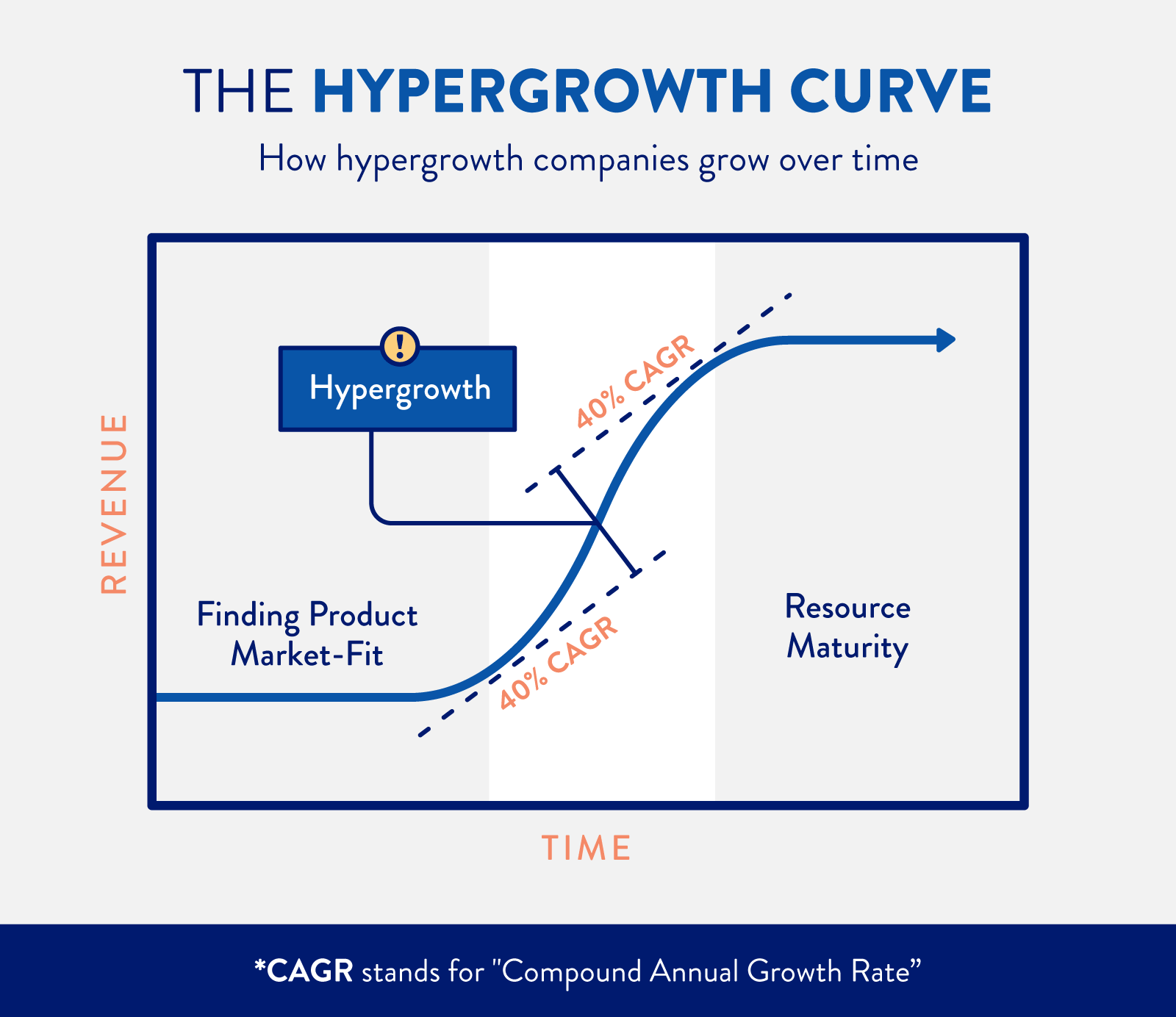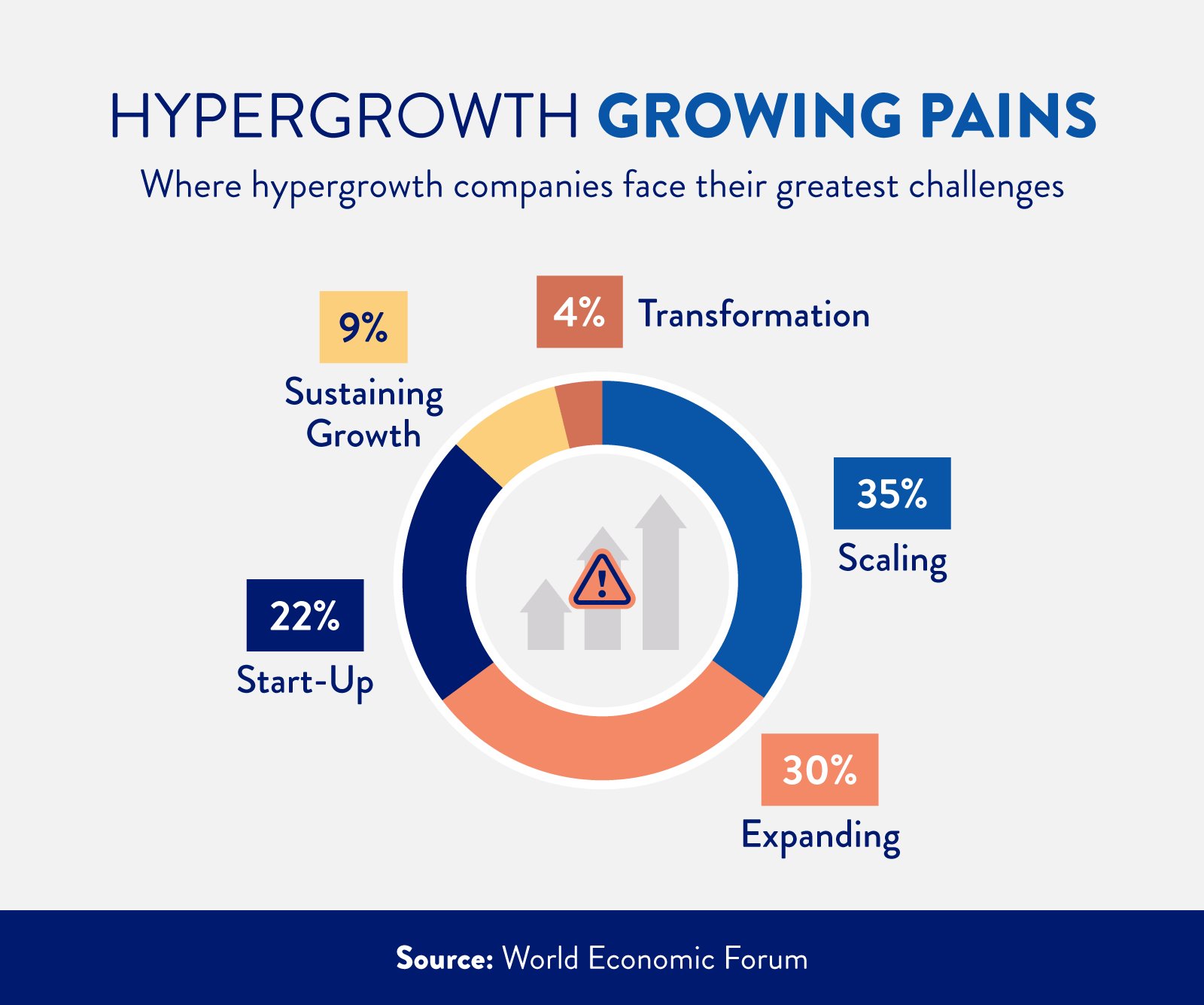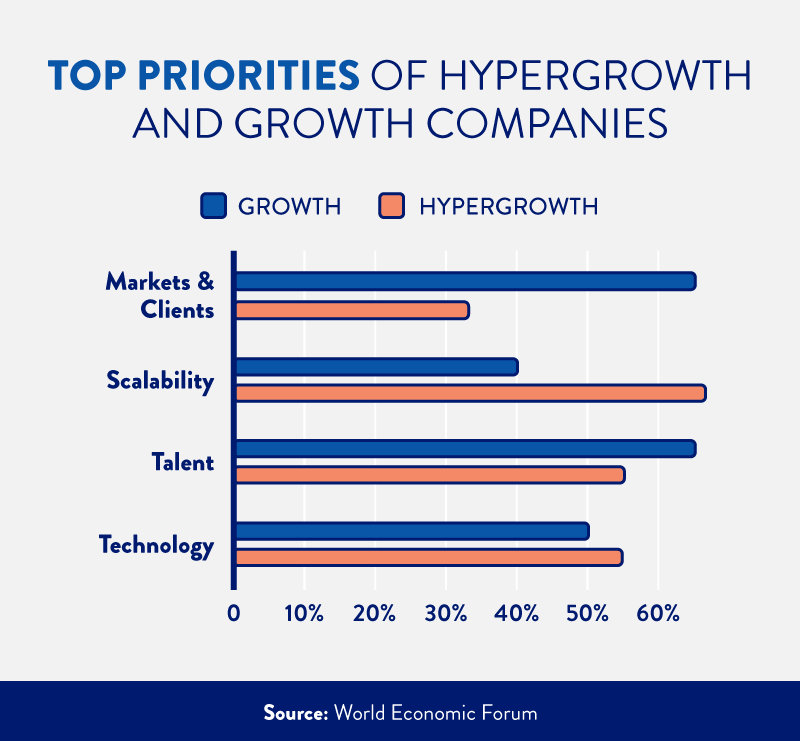More companies are seeking ways to scale faster, and hypergrowth provides a structured path to achieve just that. Hypergrowth is about creating systems that let teams keep pace with demand surges.
Although hypergrowth was once a term closely linked to startup culture, many established businesses now view it as a blueprint for capturing momentum before competitors catch up. It has become a practical model for driving growth when timing and execution matter most.
In this article, we’ll explore what hypergrowth means in today’s business context, why it matters, and the strategies and methods hypergrowth companies use to achieve sustained success.
What Is Hypergrowth?
Hypergrowth refers to a phase of extremely rapid and sustained business expansion, often defined by an annual growth rate of 40% or more in revenue. The term was first coined by Alexander V. Izosimov in Harvard Business Review to describe “the steep part of the S-curve that most young markets experience at some point, where the winners get sorted from the losers.”

A hypergrowth business is one that rapidly rises to the top of its industry, characterized by significant increases in customers, revenue, and market share. This typically occurs after achieving product-market fit, as the company moves into a scale-up stage (often Stage 4 of business growth) where demand skyrockets.
The World Economic Forum popularized the term to describe companies that achieve exponential momentum, often after reaching product-market fit and activating effective growth loops.
Why Does Hypergrowth Matter?
Companies that hit a hypergrowth stride before reaching $100 million in revenue are far more likely to scale to $1 billion in revenue thereafter. Shareholders also see outsized rewards. High-growth companies have delivered 5 times higher returns to investors compared to medium-growth peers. Hypergrowth can enable a startup to dominate its market niche, attract top talent, and achieve a premium valuation much faster than normal growth would.
A hallmark of hypergrowth companies is that they can accelerate revenue while driving customer acquisition cost (CAC) down and maintaining healthy margins. This sets hypergrowth apart from unsustainable “growth at all costs,” where expenses balloon in tandem with scale.
The Benefits and Challenges of Hypergrowth
Some of the most compelling upsides of hypergrowth come from the momentum it creates across the business:
- Market dominance: Businesses that grow rapidly often shape customer expectations and influence the category’s evolution. Reaching scale early allows them to strengthen brand recognition, secure customer mindshare, and limit the room competitors have to catch up.
- Faster return on investment: Accelerated growth means compounding revenue starts sooner. As customer volume increases, businesses can recover costs quickly and redirect the gains into high-impact areas, such as hiring, infrastructure, or international expansion.
- Stronger appeal to investors: Investors look for signals of momentum and scalability. Businesses that grow rapidly while maintaining efficient operations are often perceived as lower risk and higher reward. This credibility helps them secure funding on better terms and build relationships with long-term backers who support continued expansion.
But hypergrowth isn’t without cost. Growth for the sake of growth can lead to:

- Operational strain: Legacy systems and small teams may struggle to keep up with new demands. As demand spikes, processes that worked for 100 customers may break down at 10,000. Without scalable infrastructure, everything from billing to customer support can become bottlenecks.
- Customer dissatisfaction: Growth without user retention is simply churn disguised as progress. Teams that ignore retention during hypergrowth quickly realize they’re filling a leaky bucket.
- Burnout and turnover: Team morale often suffers when speed outpaces structure. When pace outstrips process, employees are forced to plug gaps and operate in a constant firefighting mode. This leads to decision fatigue, a dip in morale, and ultimately, attrition that slows the company just when it needs its people most.
Successful hypergrowth businesses strike a balance between the urgency of expansion and the discipline of long-term sustainability.
Key Characteristics of Hypergrowth Companies
- Customer Obsession: Hypergrowth teams deeply understand user behavior, going beyond surface metrics to uncover where customers find value or drop off.
- Data-Informed Decisions: They use customer insights to guide product improvements, personalize communication, and prioritize updates across marketing, sales, and support.
- Continuous Innovation: Innovation is ongoing, not just tied to big launches. Teams regularly test, refine, and roll out new features to stay ahead of market shifts.
- Opportunity Exploration: They don’t just improve core offerings—they explore adjacent problems to uncover fresh growth avenues.
- Scalable Infrastructure: Systems and workflows are built to scale smoothly with demand, ensuring reliability and speed don’t suffer as usage grows.
- Backend Readiness: From data architecture to customer support tools, the backend evolves alongside growth to avoid bottlenecks.
- Aggressive Marketing & Sales Alignment: Marketing and sales teams are tightly synced on target audiences, messaging, and goals.
- Full-Funnel Collaboration: Sales shares real-time feedback with product and marketing, creating a feedback loop that improves conversion and retention.

6 Key Strategies and the Hypergrowth Method
So, what do hypergrowth companies do differently to sustain their explosive growth and avoid implosion? The hypergrowth method comprises a blend of innovation, aggressive growth strategies, efficiency enhancements, and cultural principles.
Below, we break down several key pillars and examples of strategies that have enabled businesses to go from merely growing to hyper-growing.
1. Innovate on Product and Value Proposition
Hypergrowth is almost always demand-driven—a product or service that addresses a deep market need (or creates a new market altogether). Groundbreaking innovation is often the trigger that kicks off hypergrowth. OpenView Partners, an expansion-stage VC firm, describes this approach as product-led growth (PLG):
“Companies with a PLG strategy rely on product features and usage as their primary drivers of customer acquisition, retention, and expansion. It’s through this strategy that companies are able to grow faster and with less cash.”
Slack is a prime example of hypergrowth, scaling from $0 to $4 billion in four years through product-led growth. Its intuitive, real-time communication platform replaced email, driving viral adoption without a sales team. The product’s value and usability fueled explosive demand, reaching a $1.1B valuation before formal marketing began.
Slack is not alone. Many hypergrowth companies succeed by introducing disruptive products that serve unmet needs or create new behaviors. Zoom, for instance, entered a crowded market but won users with simplicity and reliability. Its global infrastructure enabled it to scale rapidly during the pandemic, reaching $4B+ ARR.
The common thread among hypergrowth businesses is their ability to deliver exceptional value at scale, whether through groundbreaking technology, innovative business models, or superior user experiences. By solving real problems in novel ways and being ready to handle massive demand, these companies unlock rapid adoption and sustained growth.
2. Execute on Aggressive Growth Marketing and Expansion
A great product is essential, but not enough for hypergrowth. Companies must pair it with an aggressive, experimental go-to-market strategy that drives rapid customer acquisition.
Hypergrowth teams adopt a “test everything” mindset—constantly running A/B tests, trying new channels, and refining campaigns to find what works. Leadership must support this fail-fast culture, knowing that frequent iteration reveals untapped growth levers.
Hypergrowth companies also diversify their acquisition strategy. When one channel slows, they pivot fast, exploring influencer marketing, communities, or overlooked paid platforms. They often spot niche opportunities competitors miss, such as high-intent long-tail keywords or emerging ad networks with lower CAC.
Geographic and segment expansion is another key lever. When domestic markets saturate, they go global—89% of unicorns expanded internationally before hitting $1B valuations. Zoom is a prime example: by building global infrastructure early, it scaled seamlessly when pandemic demand surged.
Hypergrowth firms also layer multiple go-to-market motions. Many begin with a low-touch freemium or self-serve model, then add a sales-driven approach to land enterprise clients.
3. Focus on Customer Experience, Retention, and Growth Loops
Customer acquisition gets the spotlight, but retention and customer advocacy are just as vital to hypergrowth. The fastest-growing companies don’t just win users—they keep them engaged, satisfied, and spending more over time. Expansion revenue from upsells, cross-sells, and higher usage is both efficient and scalable. In fact, acquiring $1 in upsell revenue costs roughly 24% of acquiring a new customer.
Dropbox is a classic example. It began with free and low-cost plans, then expanded into premium and business tiers, boosting average revenue per user (ARPU) by upselling value clearly aligned with customer needs. Many hypergrowth SaaS firms follow a similar model, designing pricing tiers and add-ons that grow with user adoption.
But expansion only works if churn stays low. Hypergrowth companies reduce it by investing in onboarding, customer success, and proactive churn prevention. Tactics like dunning management, payment retries, and predictive churn analysis help recover revenue and retain users before they leave. These backend systems quietly power long-term growth.
Hypergrowth businesses also build growth loops—self-reinforcing systems where existing users drive new acquisition or value. In Dropbox’s referral program, each user who invited friends unlocked more storage, creating viral momentum. Other loops include user-generated content, network effects, or reinvested revenue fueling further growth.
Focus not just on getting customers, but on keeping and activating them. When customers stick around, spend more, and invite others, they become your most powerful growth engine. That’s how hypergrowth sustains itself.
4. Build Scalable Systems and Processes (Operational Excellence)
One of the biggest challenges hypergrowth companies face is scaling operations. What works for a 20-person startup often breaks down at 200 or 2,000 employees. That’s why operational excellence is a critical strategy—investing early in scalable systems, processes, and infrastructure that can grow with the business.
Uber offers a compelling example. In its early days, drivers had to visit local offices and fill out paperwork. As Uber expanded rapidly in 2013, this manual process became a bottleneck. The company responded by creating a web-based onboarding system that let drivers sign up and verify remotely. It was a turning point that allowed Uber to meet the exploding demand. As the company grew globally, it continued adapting its systems to handle local regulations and scale efficiently.
The lesson: hypergrowth companies must constantly re-engineer their internal machinery—automating manual tasks, building robust workflows, and upgrading tech stacks to withstand rapid expansion.
Another key is avoiding the trap of constant firefighting. High-growth teams often get stuck reacting to daily issues, neglecting long-term systems. Building for scale can mean standardizing communication, investing in project management tools, or documenting workflows.
5. Nurture a Strong Culture, Team, and Leadership Foundation
Scaling a company isn’t just a technical or market challenge—it’s a human one. The team and culture you build can either power sustainable growth or become the biggest risk to it. That’s why hypergrowth companies invest heavily in hiring top talent and nurturing a mission-driven, adaptable culture.
A key strategy is hiring ahead of your needs. This doesn’t mean overstaffing but bringing in people with skills slightly beyond the current role, who can grow with the company. In fast-scaling environments, roles evolve quickly. Hiring for future demands builds resilience and helps develop internal leadership as the organization grows.

Culture must also be tended with intention. Take Coinbase: during the 2013 Bitcoin crash, many companies faltered, but Coinbase retained its team and momentum. Why? Its employees were united by a strong mission and shared belief in their work. That alignment kept morale intact through volatility and helped the company sustain 200%+ growth for years.
Leadership sets the tone. Founders and executives must foster transparency, trust, and a growth mindset.
6. Leverage Data for Customer Centricity
Breakthrough innovation is usually the result of listening closely to customers and making data-driven decisions.
While Slack’s core idea was disruptive, founder Stewart Butterfield made it a priority to actively gather and implement user feedback from early adopters. That relentless focus on what customers wanted—and how they actually used the product—helped Slack refine its offering and scale rapidly. In hypergrowth, innovation and iteration are powered by data.
No matter where a company sits on the growth curve, using customer data to guide decisions is essential. Core metrics like monthly active users (MAU) signal product engagement, while a rising churn rate may indicate misalignment with customer expectations. But metrics alone aren’t enough. To truly drive customer-centric growth, businesses must also understand the why behind the numbers.

Airbnb offers a masterclass in this approach. The company famously achieved 43,000% growth by combining quantitative metrics with qualitative insight. As former Head of Data Riley Newman put it:
“Data isn’t numbers, it’s people… It’s the voice of our customers.”
Airbnb didn’t just track user actions—they contextualized them with customer stories. By reconstructing the journeys behind key decisions, they turned data into actionable insights that shaped product features, design, and strategy.
Hypergrowth vs. Sustainable Growth: Which One is Best For You?
Not every company should pursue hypergrowth. Sometimes, steady and predictable growth is more aligned with a business’s goals, especially in industries with regulatory burdens or high capital requirements.
Hypergrowth is best suited for:
- Digital-first businesses with minimal marginal costs
- Products with viral potential or strong network effects
- Teams that are comfortable making fast, data-backed decisions
Sustainable growth, on the other hand, prioritizes resilience and consistency. It focuses on margin expansion, strong customer relationships, and long-term viability.
The decision isn’t binary. Businesses can choose to enter a hypergrowth phase temporarily, often during product launch or funding rounds, then return to a more measured pace. The key is knowing when to accelerate and when to consolidate.
Tools & Frameworks for Managing Hypergrowth
Hypergrowth companies don’t scale on instinct alone; they rely on proven systems to maintain pace, precision, and team alignment.
- Growth Models: Frameworks like AARRR (Acquisition, Activation, Retention, Revenue, Referral) and RARRA (Retention, Activation, Referral, Revenue, Acquisition) help teams prioritize actions across the user journey. These models guide experimentation and bring clarity to funnel optimization.
- Analytics Tools: CleverTap’s analytics suite is purpose-built for hypergrowth. It captures real-time behavioral data, enabling teams to track every user action across app and web channels. With advanced segmentation, you can group users by behavior, recency, frequency, or custom properties to tailor engagement. The platform’s visual tools, like Funnels, Flows, Cohorts, and Pivots, help teams uncover conversion drop-offs, understand retention, and launch automated campaigns to address gaps instantly. You also get predictive analytics that identify users likely to churn or convert, so you can prioritize actions that drive growth.
- Team Workflows and Sprint Cadences: Agile sprints, cross-functional squads, and shared metrics ensure teams ship fast without breaking process. Documentation and clear rituals, like retrospectives and planning meetings, allow hypergrowth to scale sustainably across departments.
Ready to grow smarter and faster? Learn how CleverTap can help.
Is Your Business Ready for Hypergrowth?
Before chasing 40% year-over-year gains, evaluate if your foundation is strong enough to handle that pace. Ask yourself:
- Do we have product-market fit?
- Can our infrastructure scale quickly?
- Are our teams aligned and agile?
- Is churn under control?
- Do we have the data visibility to act in real time?
If the answer is yes, the hypergrowth method may be your next strategic play. And if you’re looking for a growth engine that can keep up with your ambition, CleverTap offers the tools, analytics, and engagement automation you need to fuel and sustain hypergrowth.
Subharun Mukherjee 
Heads Cross-Functional Marketing.Expert in SaaS Product Marketing, CX & GTM strategies.
Free Customer Engagement Guides
Join our newsletter for actionable tips and proven strategies to grow your business and engage your customers.















































